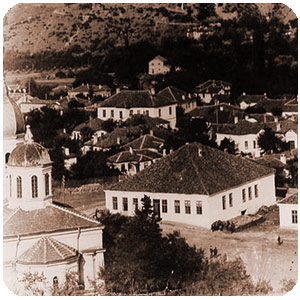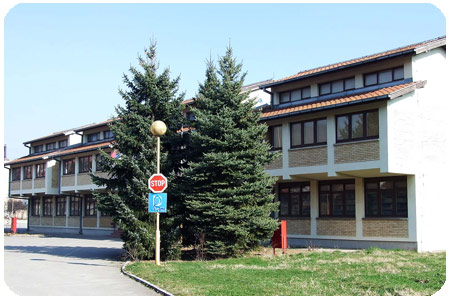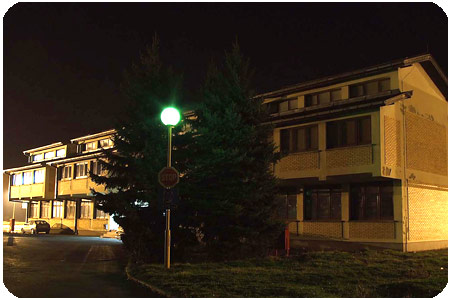
This beacon of knowledge is proud of its long history. Its history is divided into four periods, and that division is based on objective examples, which have determined not only the work, but also the existence of the school.

The first school building
The first stage covers the period from the founding of the Gymnasium, from 1891 to 1920, when Caribrod was within the borders of Bulgaria; therefore, the Gymnasium operated according to the Laws of education which were in force at the time. The second stage covers the period from 1920 to 1941, that is, the times after the First World War, when Caribrod and its surrounding areas were annexed to the Kingdom of the Serbs, Croats, and Slovenes, when the conditions for the existence and operating of the Gymnasium were changed – first of all, the classes were not conducted in Bulgarian, but the Serbian language. In the third stage which lasted from 1941 to 1944, new changes occurred. After the disintegration of the Kingdom of Yugoslavia, Bulgarian rule was re-established in Caribrod region, and classes were conducted in the Bulgarian language again, and education was established according to the laws of Bulgaria. And finally, the fourth stage which includes the times of new Yugoslavia from 1945 until today, a new country with people’s democratic order, new laws, and new conditions.

School nowadays
During these times, it was not only the regimes, and countries that were changed, but also the name of the town. Since 1950, instead of Caribrod, the town has been called Dimitrovgrad.
As for the real name of the Gymnasium, it was not only called Caribrod or Dimitrovgrad Gymnasium. Immediately after its founding, it was named ‘Caribrod Mixed Gymnasium’. During the Kingdom of Yugoslavia, it was named ‘Six-grade Gymnasium in Caribrod. In the period from 1941 to 1945, its name was Mixed Real Gymnasium ‘Knjaz Kiril’ in Caribrod, while in 1945, it was named People’s Mixed Gymnasium ‘Josip Broz Tito’. After that, it was called ‘Gymnasium in Dimitrovgrad. Later, it was named Gymnasium ‘Kirilo i Metodije’ in Dimitrovgrad, and finally it was called Gymnasium ‘Sveti Kirilo i Metodije in Dimitrovgrad (Saints Cyril and Methodius).

The new school building
The periodization which was made in the Yearbook of the Gymnasium in Dimitrovgrad, along with several changes in its name, indicate that one of the basic specificities in its existence is that it is located in a very small town right next to the border: until 1920, it was the border between Bulgaria and Serbia, and from 1920, it was the Yugoslav – Bulgarian border. Frequent wars were the reason why the Region of Caribrod was sometimes within the borders of Bulgaria, and sometimes within the borders of Yugoslavia. This fact determined both the existence of the Gymnasium, and radically changed the conditions and ways of operating, starting from completely different educational systems, to the languages in which classes were conducted.

Night shot of the school
The changes did not pass without difficulties and consequences, both for the students, and for the teachers who conducted the classes. Thus, for example, during the wars – especially during the First World War, a significant part of the subjects was not taught because the teachers were mobilized. After the annexation of Caribrod to the Kingdom of the Serbs, Croats, and Slovenes, it was ordered that classes be conducted in Serbian, which was also a difficulty for both teachers and students. Because of political circumstances, during 1945, certain teachers who were on the side which lost the war were ordered to leave the Gymnasium.
Due to the need to provide regular work and quality professional teaching staff, an international agreement was reached to hire teachers from Sofia who conducted classes in Bulgarian. Although Caribrod remained within the borders of New Yugoslavia after the Second World War, schooling was conducted in Bulgarian, because national minorities used the right to equality, and the right to use their mother tongue in education, social and cultural life was the most basic and important element in achieving national equality.
However, the devil knew no rest even then. After the events which happened in 1948, the conflicts between Stalin and Tito, and the establishing of very bad relations between Yugoslavia and Bulgaria forced those teachers to leave Caribrod, and the Gymnasium lost its professional staff which had taught several subjects. At that time, the management of the Gymnasium sought a solution among the local staff – first to provide classes for all the subjects, and then for all the subjects to be conducted professionally. From then on, the personnel issue has not been a problem with any of the subjects. A new local staff has come, which mainly consists of former students of this Gymnasium. They have achieved enviable success in working with generations of students, and helping them to graduate from secondary school.
Today’s building of the school, which was built in 1986, consists of 10 classrooms, 5 adequately equipped cabinets, a hall with beautiful paintings, mainly painted by former students, a subsequently built gym, a library with more than 22,000 books and magazines in Serbian and Bulgarian.
The basic value of the Gymnasium consists of ambitious students and good teachers who boldly step towards the school of the future, and who are aware of the necessity of professional and spiritual development. The arguments in favour of that are two projects approved by the Ministry of Education and Sport, which aim to improve and modernize the educational process, and open the door for cooperation with other schools from Serbia and abroad. The motto ‘School without walls’ represents a vision of the development of the school, which will be open to new methods, technologies, interdisciplinary training of teachers, and will follow modern standards, which will make students the subject of the educational process.
The school has participated in the implementation of many other projects with schools and NGOs from Serbia, Bulgaria, Croatia, Bosnia and Herzegovina, etc., as a project partner.